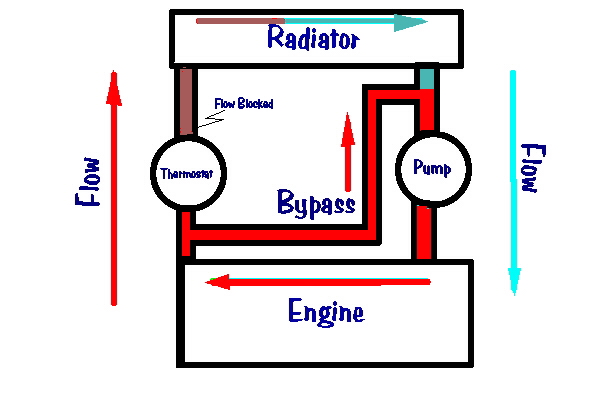An engine coolant system is an essential component of any internal combustion engine, as it helps to regulate the temperature of the engine and prevent overheating. Engine coolant flows through a series of passages, including the engine block, cylinder head, and radiator. One critical component of the engine coolant system is the thermostat, which helps regulate the flow of coolant and maintain the engine’s optimal temperature. In this blog post, we will explore engine coolant ports with a thermostat in position, how they work, and why they are important.
Firstly, let’s talk about engine coolant ports. Coolant ports are passages in the engine block, cylinder head, and other components of the engine coolant system that allow coolant to flow through the engine. They are usually located near the hottest parts of the engine, such as the cylinders or exhaust system, where heat can be generated quickly. Coolant ports are typically designed to be as large as possible to allow for maximum coolant flow, which helps to dissipate heat efficiently.
Now, let’s move on to the thermostat. The thermostat is a valve that sits between the engine and the radiator and regulates the flow of coolant through the engine. It does this by opening and closing at specific temperatures, allowing coolant to flow when the engine is hot and restricting it when the engine is cold. The thermostat achieves this through the use of a temperature-sensitive spring that expands and contracts with changes in temperature. When the engine is cold, the spring is contracted, and the valve is closed, preventing coolant from flowing through the engine. As the engine heats up, the spring expands, causing the valve to open and allowing coolant to flow through the engine and keep it at the optimal temperature.
An engine coolant system is an essential component of any internal combustion engine, as it helps to regulate the temperature of the engine and prevent overheating. Engine coolant flows through a series of passages, including the engine block, cylinder head, and radiator. One critical component of the engine coolant system is the thermostat, which helps regulate the flow of coolant and maintain the engine’s optimal temperature. In this blog post, we will explore engine coolant ports with a thermostat in position, how they work, and why they are important.
Firstly, let’s talk about engine coolant ports. Coolant ports are passages in the engine block, cylinder head, and other components of the engine coolant system that allow coolant to flow through the engine. They are usually located near the hottest parts of the engine, such as the cylinders or exhaust system, where heat can be generated quickly. Coolant ports are typically designed to be as large as possible to allow for maximum coolant flow, which helps to dissipate heat efficiently.
Now, let’s move on to the thermostat. The thermostat is a valve that sits between the engine and the radiator and regulates the flow of coolant through the engine. It does this by opening and closing at specific temperatures, allowing coolant to flow when the engine is hot and restricting it when the engine is cold. The thermostat achieves this through the use of a temperature-sensitive spring that expands and contracts with changes in temperature. When the engine is cold, the spring is contracted, and the valve is closed, preventing coolant from flowing through the engine. As the engine heats up, the spring expands, causing the valve to open and allowing coolant to flow through the engine and keep it at the optimal temperature.
Finally, let’s talk about engine coolant ports with a thermostat in position. These are coolant ports that are specifically designed to work with a thermostat. Typically, these ports will have a small channel that leads to the thermostat housing, allowing coolant to flow directly through the thermostat. When the thermostat is closed, coolant cannot flow through the engine, so it is redirected back to the radiator to be cooled. When the thermostat opens, coolant flows through the engine, helping to regulate its temperature.
Engine coolant ports with a thermostat in position are critical to the proper function of an engine coolant system. Without them, coolant would not be able to flow through the engine properly, which could lead to overheating, engine damage, and potential safety hazards. If you suspect that your engine coolant system is not functioning correctly, it is essential to have it inspected and repaired by a qualified mechanic to prevent damage to your engine and ensure that your vehicle remains safe to drive.

Finally, let’s talk about engine coolant ports with a thermostat in position. These are coolant ports that are specifically designed to work with a thermostat. Typically, these ports will have a small channel that leads to the thermostat housing, allowing coolant to flow directly through the thermostat. When the thermostat is closed, coolant cannot flow through the engine, so it is redirected back to the radiator to be cooled. When the thermostat opens, coolant flows through the engine, helping to regulate its temperature.
Engine coolant ports with a thermostat in position are critical to the proper function of an engine coolant system. Without them, coolant would not be able to flow through the engine properly, which could lead to overheating, engine damage, and potential safety hazards. If you suspect that your engine coolant system is not functioning correctly, it is essential to have it inspected and repaired by a qualified mechanic to prevent damage to your engine and ensure that your vehicle remains safe to drive.
In conclusion, engine coolant ports with a thermostat in position are an essential component of any internal combustion engine.










